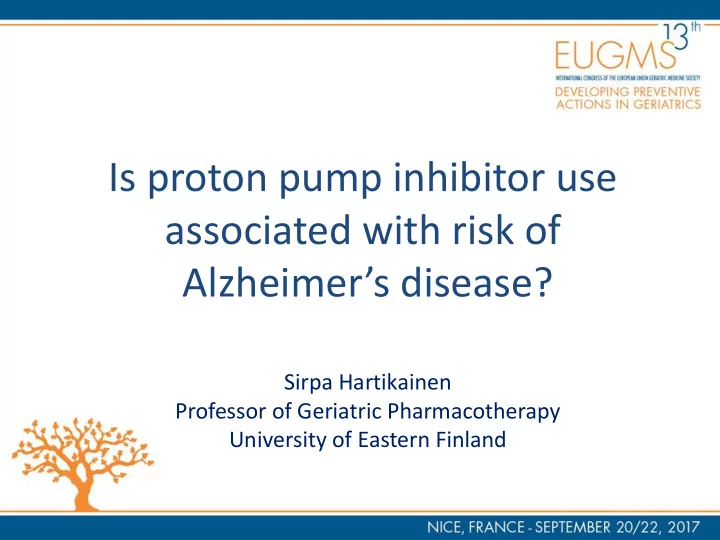

Is proton pump inhibitor use associated with risk of Alzheimer’s disease? Sirpa Hartikainen Professor of Geriatric Pharmacotherapy University of Eastern Finland
CONFLICT OF INTEREST DISCLOSURE I have the following potential conflicts of interest to report - Lecture fee from MSD - Lecture fee form Professio
Objective • To investigate whether PPI use is associated with an increased risk of incident, clinically verified Alzheimer’s disease – Is there dose-response relationship and differences between specific PPIs 13.10.2017 3
MEDALZ study • Includes all community-dwelling persons diagnosed with Alzheimer’s Disease (AD) during 2005-2011 in Finland N=70,718 – Identified from Special Reimbursement register • For a nested case-control design, up to four matched comparison persons without AD were identified for each case, N=282,858 – Matched for age, gender and region of residence – Identified by Social Insurance Institution, from register including all residents 13.10.2017 4
Study design – nested case-control study 0=date of AD diagnoses
Exposure and analyses • Proton pump inhibitor (PPI) use – any use (ATC-code A02BC), – cumulative duration of use, cumulative amount per duration =dose • Lag window for exposure: observation period for exposure ended 3 years before AD diagnosis in the main analyses – Sensitivity analysis with 5 year lag and without any lag window • Conditional logistic regression analyses (matched design taken into account) 6
Results • Persons with and without AD – 65% were female – Median age of persons with AD 80.8 • Use of PPIs was frequent among both groups, with no lag window – 44.1% of persons with AD used PPIs – 42.3% of comparison persons used PPIs 13.10.2017 7
Results Exposure Unadjusted OR (95% CI) Adjusted OR (95% CI) Any use of PPIs before Alzheimer’s Disease diagnoses No lag 1.08 (1.06-1.09) 1.02 (1.00-1.04) 3 year lag 1.06 (1.04-1.07) 1.03 (1.00-1.05) 5 year lag 1.07 (1.05-1.09) 1.05 (1.03-1.07) Analyses adjusted for: cardiovascular diseases, diabetes, history of depression, history of stroke and number of drugs (0, 1-4, 5- 9, ≥10), measured at the beginning of lag window 13.10.2017 8
Results – cumulative duration of use Exposure Unadjusted OR Adjusted OR (95% (95% CI) CI) 3 year lag window <1 year 1.06 (1.04-1.08) 1.03 (1.01-1.05) 1-3 years 1.05 (1.01-1.10) 1.01 (0.97-1.06) ≥3 years 1.02 (0.97-1.08) 0.99 (0.94-1.04) Analyses adjusted for: cardiovascular diseaes, diabetes, history of depression, history of stroke and number of drugs (0, 1-4, 5- 9, ≥10), measured at the beginning of lag window 13.10.2017 9
Results – dose (in Defined Daily Doses DDDs/day) Exposure Unadjusted OR Adjusted OR (95% (95% CI) CI) 3 year lag window (cumulative purchased amount divided by duration of use), DDDs per day 0.0001-0.4999 1.04 (0.98-1.10) 1.01 (0.96-1.07) 0.5-0.49999 1.05 (1.03-1.07) 1.02 (1.00-1.04) 1.0-1.49999 1.09 (0.95-1.18) 1.06 (1.02-1.10) ≥1.5 1.06 (0.95-1.18) 1.03 (0.92-1.14) Analyses adjusted for: cardiovascular diseaes, diabetes, history of depression, history of stroke and number of drugs (0, 1-4, 5- 9, ≥10), measured at the beginning of lag window 13.10.2017 10
Results – specific PPIs Exposure Unadjusted OR (95% CI) Adjusted OR (95% CI) 3 year lag window Omeprazole 1.06 (1.02-1.10) 1.03 (0.99-1.07) Pantoprazole 1.03 (1.00-1.07) 1.01 (0.97-1.05) Lansoprazole 1.07 (1.04-1.11) 1.05 (1.01-1.09) Combination: Rabeprazole 1.08 (0.84-1.40) 1.06 (0.82-1.37) use of two or more PPI Esomeprazole 1.00 (0.95-1.04) 0.98 (0.93-1.02) drugs during the Combination 1.07 (1.04-1.10) 1.04 (1.01-1.07) observation period Analyses adjusted for: cardiovascular diseaes, diabetes, history of depression, history of stroke and number of drugs (0, 1-4, 5- 9, ≥10), measured at the beginning of lag window 13.10.2017 11
Lack of dose response in both dose and duration of use underline the lack of medically meaningfull association between proton pump inhibitor use Alzheimer’s Disease. When studing medication as a risk for Alzheimer’s Disease, it is important use lag window and to do sensitivity analyses CONCLUSION
Published in Am J Gastroenterology 2017 13.10.2017 13
Thank you for your attention! uef.fi
Recommend
More recommend